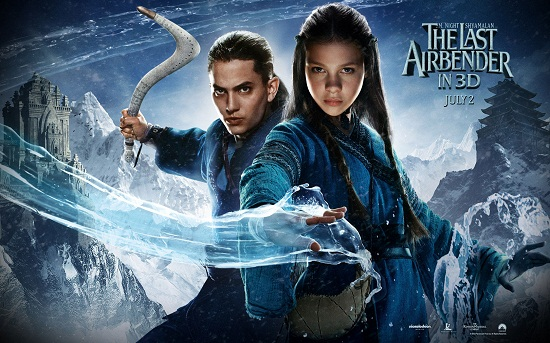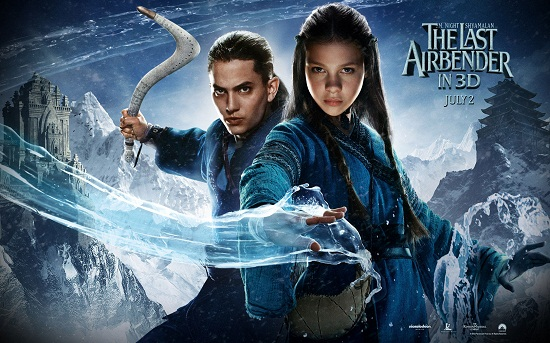**Name movie: The Last Airbender (2010)**
_The Last Airbender_ is a 2010 live-action film adaptation of the beloved animated series _Avatar: The Last Airbender_, directed by M. Night Shyamalan. The film aimed to bring the rich, elemental world of the animated series to life, drawing on themes of destiny, balance, and the epic battle between good and evil. Despite its high expectations and visually stunning effects, the movie faced mixed to negative reception due to its deviations from the source material, casting decisions, and pacing issues. Nonetheless, _The Last Airbender_ remains an intriguing chapter in the saga of this iconic franchise.

The film’s storyline centers on Aang (Noah Ringer), a young boy who is revealed to be the Avatar—a being capable of controlling all four elements: Water, Earth, Fire, and Air. The Avatar is the only one who can bring balance to a world ravaged by war, but after being trapped in ice for a hundred years, Aang wakes to find that the world has been drastically altered. The Fire Nation, led by Fire Lord Ozai (Cliff Curtis), has taken control of the other nations, leaving devastation in its wake.
Aang is discovered by Katara (Nicola Peltz), a waterbender, and her brother Sokka (Jackson Rathbone), members of the Southern Water Tribe. Together, they embark on a journey to help Aang master the elements and defeat the Fire Nation, restoring peace to the world.
**Aang**: As the last surviving Airbender and the Avatar, Aang carries the weight of the world on his shoulders. Despite his young age, he must quickly adapt to the responsibilities of saving a world in chaos. In the film, Aang’s character is portrayed with a sense of innocence and uncertainty, but his journey is defined by his growing realization of his role in the world’s destiny.
**Katara**: Katara is the heart of the group, a kind and determined waterbender who believes in Aang’s ability to bring peace. As one of the last remaining waterbenders from her tribe, she has a deep connection to the elements and serves as a mentor to Aang in his quest to master waterbending.
**Sokka**: Katara’s brother, Sokka, is a brave but non-bending warrior. He provides much of the comic relief in the animated series, but in the film adaptation, his character is portrayed more seriously, focusing on his tactical mind and protective instincts.
**Prince Zuko**: One of the most complex characters, Prince Zuko (Dev Patel) is a banished prince of the Fire Nation, obsessed with capturing the Avatar to restore his honor. His internal struggle between fulfilling his father’s expectations and finding his own path is central to his character arc. Zuko’s journey from antagonist to anti-hero is one of the most compelling storylines in the _Avatar_ universe, although the film simplifies much of this complexity.
**Iroh**: General Iroh (Shaun Toub) is Zuko’s wise and compassionate uncle. He acts as a mentor to Zuko, guiding him through his internal battles and helping him realize that honor doesn’t come from cruelty or domination.
The world of _The Last Airbender_ is divided into four nations, each tied to one of the four classical elements: Water, Earth, Fire, and Air. The citizens of these nations possess the ability to “bend” their respective elements, with the Avatar being the only one capable of bending all four.
1. **Water Tribe**: Aang’s first major challenge is to learn waterbending from the Northern Water Tribe. This group is known for their mastery of waterbending and their deep spiritual connection with nature.
2. **Earth Kingdom**: Although less explored in the film, the Earth Kingdom plays a crucial role in the larger story, with earthbenders being powerful warriors who control the land itself.
3. **Fire Nation**: The antagonistic force of the story, the Fire Nation, seeks to dominate the world under the leadership of Fire Lord Ozai. Firebenders use the destructive power of fire and are known for their aggressive nature.
4. **Air Nomads**: The Air Nomads were a peaceful civilization wiped out by the Fire Nation in their quest to eliminate the Avatar. Aang, the last of his kind, holds the traditions and values of the Air Nomads, which emphasize harmony with nature and spiritual balance.
_The Last Airbender_ explores various themes, with the most significant being balance. As the Avatar, Aang is tasked with maintaining the balance between the four nations, and by extension, the balance of the world itself. The Fire Nation’s thirst for power has disrupted this equilibrium, and it is up to Aang to restore harmony.
The theme of destiny is another central element of the story. Aang struggles with accepting his role as the Avatar, fearful of the great responsibility it entails. Zuko, too, grapples with his destiny, initially believing his path to redemption lies in capturing Aang, but later realizing that his true path may lead elsewhere.
Additionally, the movie touches on the interconnectedness of the elements, symbolizing the need for unity among the nations. Each nation’s bending ability represents a different aspect of the world—fluidity, strength, passion, and freedom—and only by working together can true peace be achieved.
One of the standout aspects of _The Last Airbender_ is its visual effects, which bring the bending of elements to life. The film showcases visually stunning scenes where characters manipulate water, fire, earth, and air with impressive choreography and CGI. The climactic battle scenes, where benders engage in elemental combat, are dynamic and engaging, making use of advanced visual technology to create a sense of immersion.
However, while the effects were praised, many fans of the original series felt that the film failed to capture the fluid and graceful style of bending that made the animated series so unique. The live-action adaptation’s bending sequences were slower and less intricate, taking away some of the awe that fans expected.
Despite its promising premise, _The Last Airbender_ was met with significant criticism. Fans of the animated series were disappointed by the casting choices, which many felt did not reflect the characters’ cultural backgrounds. Furthermore, the film’s pacing was rushed, cramming the events of an entire season into a two-hour runtime, leaving little room for character development or exploration of the world’s rich lore.
The dialogue and acting were also points of criticism, with many feeling that the film lacked the emotional depth and humor that made the animated series so beloved. The complex character arcs, especially Zuko’s, were simplified, and the film’s serious tone felt at odds with the lighter, more whimsical elements of the source material.
Ultimately, _The Last Airbender_ is viewed as a missed opportunity to bring one of the most beloved animated series to the big screen. While it succeeded in creating a visually captivating world and had the potential to kickstart a franchise, the film’s execution left much to be desired.
For newcomers unfamiliar with the original series, the film may offer an intriguing introduction to the world of the four nations, but for fans of _Avatar: The Last Airbender_, it remains a flawed adaptation that fails to capture the spirit and depth of the original story.
_The Last Airbender_ (2010) is an ambitious attempt to adapt a complex, beloved story into a live-action film. With its stunning visuals and imaginative worldbuilding, the film brings the elemental powers of air, water, fire, and earth to life. However, its shortcomings in storytelling, character development, and faithfulness to the source material leave it as a divisive entry in the franchise.

